A nutritious, balanced cat diet is essential to keeping your furry friend happy and healthy. Follow these vet-approved tips to guarantee your cat is getting the nutrients it needs.
The Very Best Diet for Cats, According to Vets
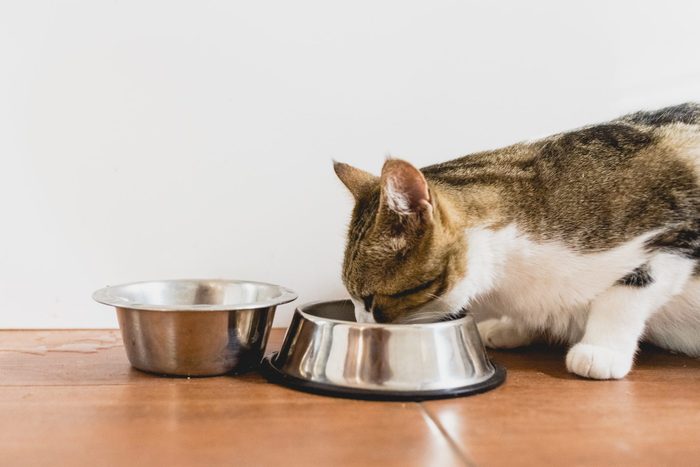
What to feed your furry felines
Keeping our cats nourished and healthy not only means they feel great inside and out, but they also lead longer, more fulfilling lives. That equals plenty of cuddles and playtime for them and reassurance for you that you’re doing a great job as a proud pet parent. One of the most important ways we can ensure our cats stay healthy is through a vet-approved cat diet.
“Nutrition is key to pets’ overall health and wellness, because what they eat fuels every part of their body and life,” says Whitney Miller, DVM, chief veterinarian at Petco. It also ensures they remain at a healthy weight and are getting enough nourishment while avoiding unhealthy or potentially toxic foods.
And while it might not seem obvious, one cat fact is certain: Cat diets are actually very particular. Cats are what’s referred to as “obligate carnivores,” which means they must eat high amounts of meat in order to nourish their bodies and live long, healthy lives. To help you navigate the world of feline nutrition, we asked experts to weigh in on the optimal cat diet—including whether cats can drink milk or eat human foods like pumpkin. Your furry feline friend will thank you for prioritizing their health.
Get Reader’s Digest’s Read Up newsletter for more pet insights, humor, cleaning, travel, tech and fun facts all week long.
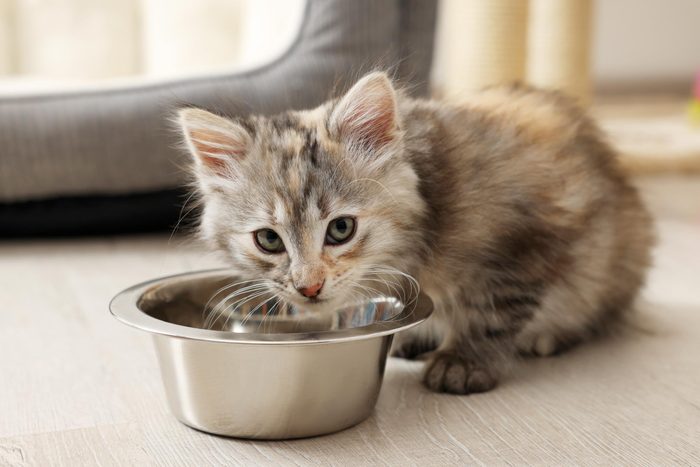
Select food tailored to your cat’s stage in life
One of the most important cat-diet factors to consider is your cat’s age. Different life stages mean different activity levels and nutritional needs, Dr. Miller says. For example, kittens are generally far more active than their senior counterparts, and they also need additional nutrition to help them in their quick-growing process. For this reason, it’s important to purchase balanced food for kittens until they become adult cats.
Senior cats also have different nutritional needs. The American Animal Hospital Association (AAHA) notes that mature kitties often need more protein to account for muscle loss and to support their renal systems, while requiring foods lower in fat and calories to help prevent weight gain.
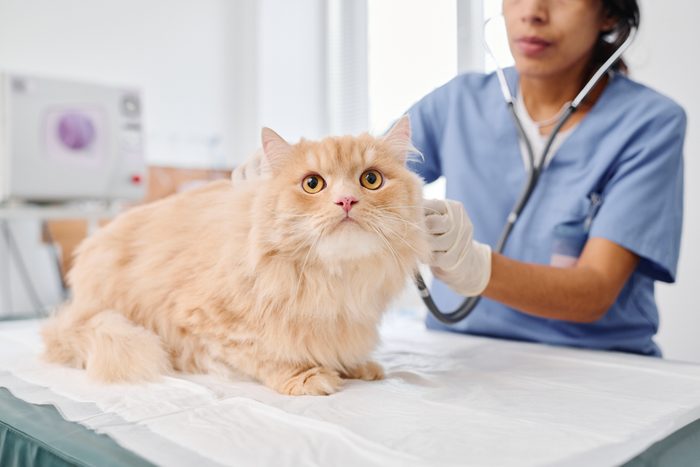
Consider any health conditions
In addition to buying food according to your cat’s life stages, you’ll also want to consider any potential ailments or sensitivities your cat may acquire over time. For example, mother cats nursing their kittens require a much higher caloric diet, according to the Veterinary Centers of America (VCA). Other cats end up needing more simplistic diets due to allergies. Your veterinarian can help you navigate these particular needs.
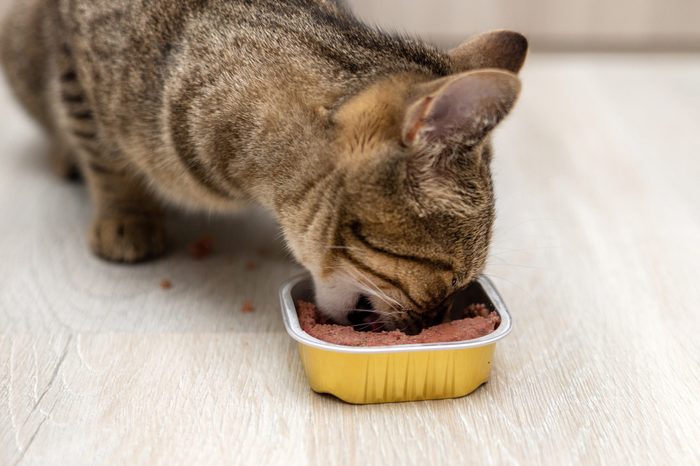
Incorporate meat-based protein
Even if you’re a proud vegetarian, your sweet feline needs to consume meat protein as part of their cat diet. “Because cats are obligate carnivores, their diets must contain specific amino acids and nutrients they cannot produce themselves,” Dr. Miller says. “Meat should make up the vast majority of their diet, so make sure the bulk of the protein in your cat’s diet comes from meat, poultry or fish.” The best food for cats ensures appropriate levels of these nutrients are included.
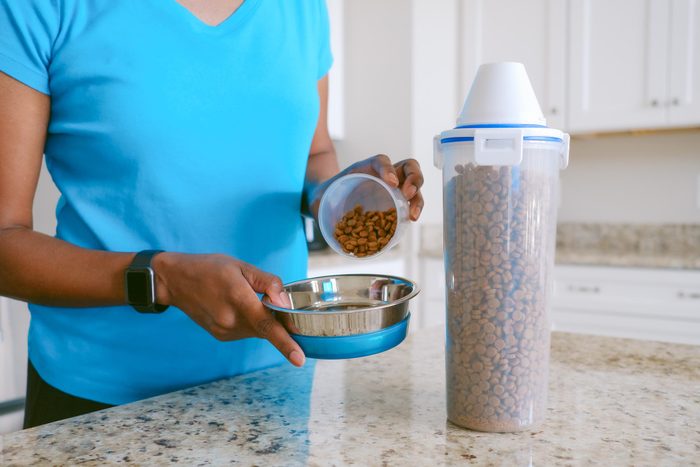
Avoid high amounts of grain
Cats don’t need large amounts of grain to be healthy, so avoid foods that include grain as a primary part of the ingredient list. Grains tend to be cheap “filler,” which means you get more food for less money, but it’s not necessarily nutritious. “Fillers are ingredients that serve no nutritional purpose and should be avoided,” says Jennifer Coates, DVM, a veterinarian at Chewy. “Grains, and more generally carbohydrates, should only play a small role as a source of energy in a cat’s diet.”
Too many grains in a cat’s diet can lead to malnutrition, obesity, organ issues and GI tract issues.
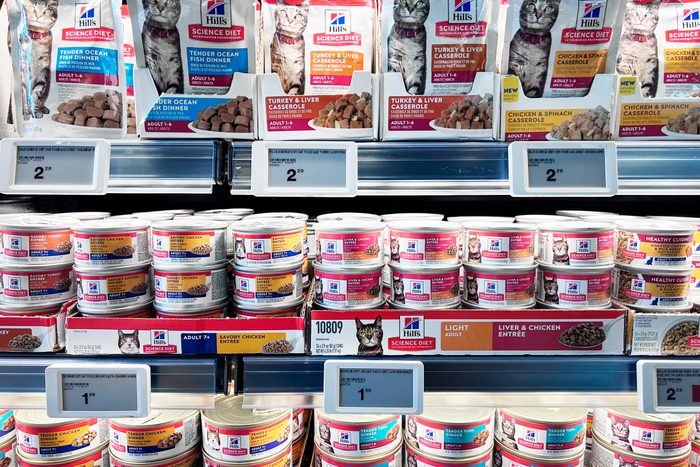
Look for the AAFCO seal of approval
Instead of sweating over the ingredient list, you can look for a stamp or statement from the Association of American Feed Control Officials (AAFCO). When you see this on cat food packaging, it means the cat food brand, ingredient list and nutritional label have met specific guidelines that ensure the food you’re purchasing is balanced and nutritious, says Dr. Coates.
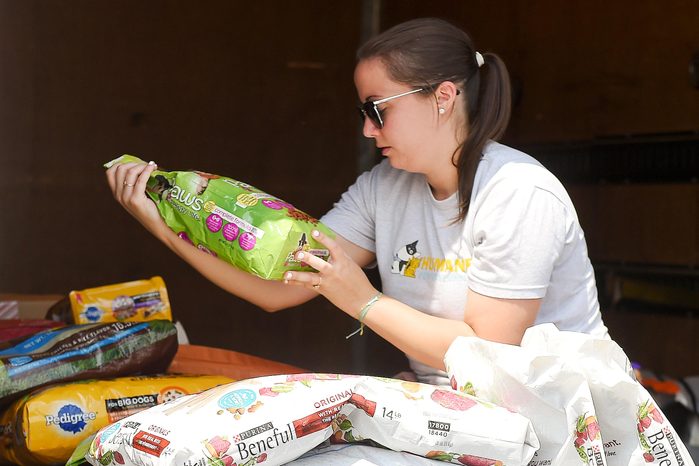
Beware of gimmicky labels
Pet food companies often employ clever marketing tactics to gain the attention of customers (and their wallets). But be aware of gimmicky labels with words such as “primitive,” “ancestral” or “wild,” which can lead you astray when choosing the best cat food, says Dr. Coates. “These terms are pure marketing,” she says. “Instead of looking for flashy words, pet parents must look closely at a food’s label to determine whether it could be a good option.”
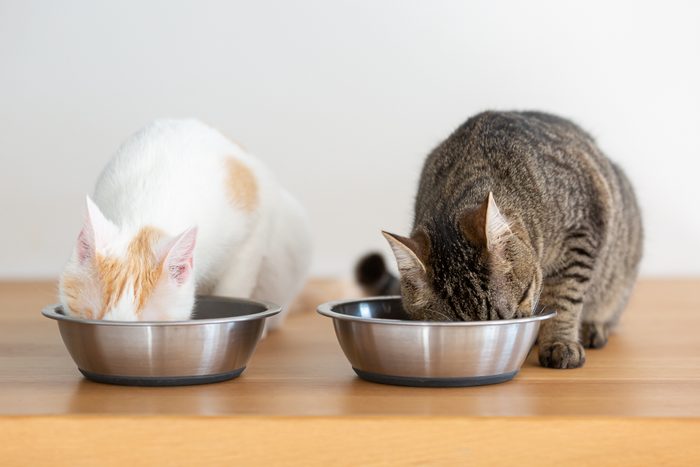
Opt for meal-feeding versus free-feeding
Pouring food into your kitty’s food bowl and calling it a day (or weekend) may seem like the easiest route and allows your kitty to graze, but Dr. Miller says to think twice about this approach. “I always recommend meal-feeding cats, even though free-feeding is common,” she says. “Meal-feeding can help reduce obesity risk, a very common health issue with cats.”
Another reason meal-feeding is the best cat diet? Wet food should not be left out for long periods of time, she says.
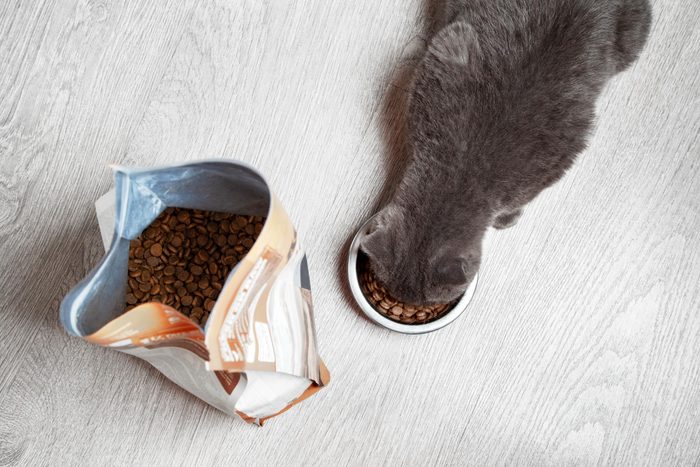
Follow on-label feeding instructions
A chunky cat may be cute, but extra weight can take a toll on their little bodies over time. For that reason, it’s important to make sure you’re feeding them the right amount of calories every day, Dr. Coates says. While meal-feeding can help with this, you’ll also want to make sure you’re reading the on-label feeding instructions that indicate how much food to give your cat according to their current weight.
The recommended amount of food listed on the packaging is often based on the advice of veterinary nutritionists, who carefully formulate each product, so following the package instructions is not only important for weight gain, but also safety.
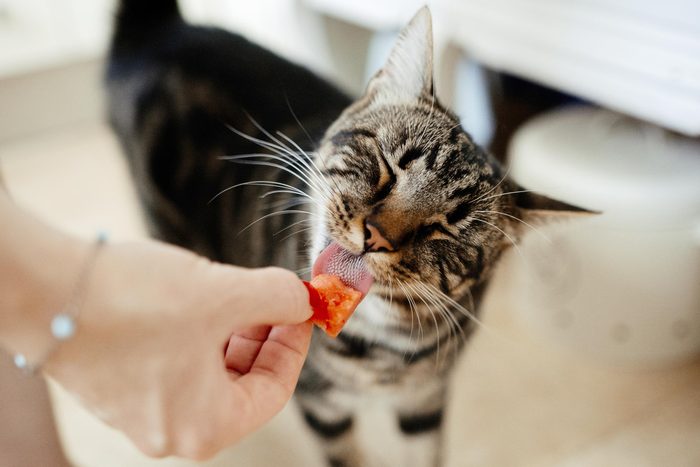
Offer human foods sparingly
As long as your cat is eating cat food that’s nutritionally balanced, you can supplement sparingly with some tasty fruits and vegetables, such as sweet potato, steamed broccoli and banana—but just do so carefully.
“Many vegetables are high in carbs, and it’s best to limit the amount of carbs your cat is eating,” Dr. Miller says. “However, some fruits and veggies can be good treats and offer ancillary health benefits to supplement a primarily protein-based diet. For example, cooked carrots are loaded with vitamins, fiber and magnesium. Strawberries and pumpkin are good options for cats as well.” Small pieces of cooked meat or fish can make wonderful treats for cats too, she says.
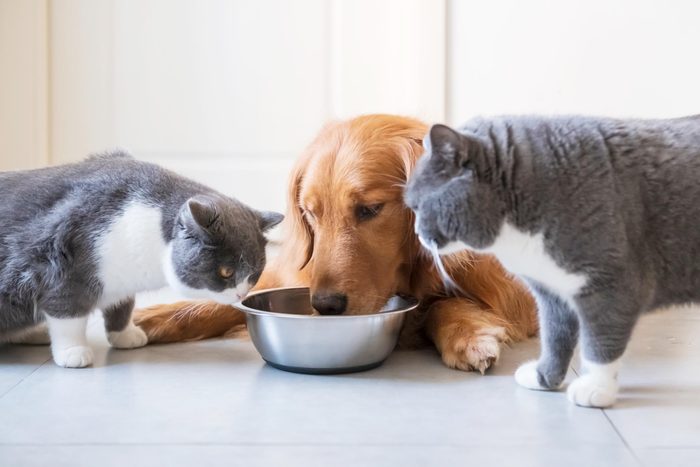
Never feed cats dog food
At some point you might have wondered if cats can eat dog food—after all, they seem to look the same. But the answer is a resounding no. “If your cat occasionally steals a mouthful from your dog’s bowl, you have nothing to worry about, but make sure that 90% or more of your cat’s diet is made up of cat food,” Dr. Coates says. This is because cats rely heavily on diets rich in animal-based protein. Dogs require an entirely different set of dietary needs, and therefore the best diet for dogs is formulated according to their nutritional satisfaction.
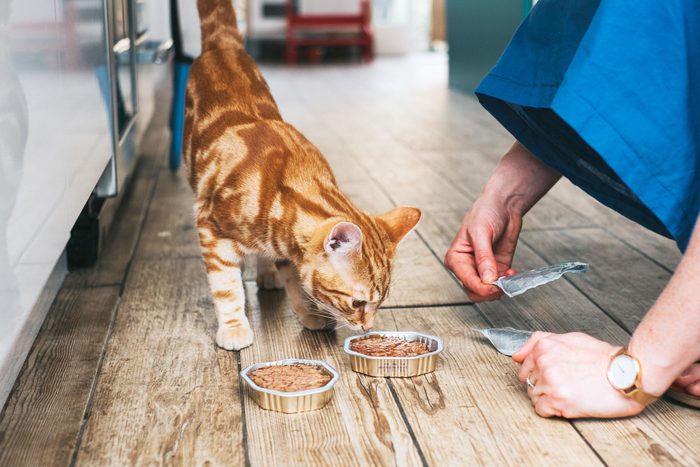
Consider wet food over dry
Quality matters most when deciding what to feed cats, but many veterinarians argue that nutritionally balanced wet food is the superior option for cats over dry kibble. “Cats are naturally desert animals and don’t have the same drive as dogs to drink regularly,” Dr. Miller explains. (Could that be the reason so many cats hate water?) “This can lead to chronic under-hydration. Wet food is a great way to provide extra hydration for your cat.”
Just be aware that some wet food is low quality, so you still want to read the labels. And know that wet food requires more diligent cat bowl cleaning, since it can be a harboring ground for bacteria and make your cat sick, adds Dr. Coates.
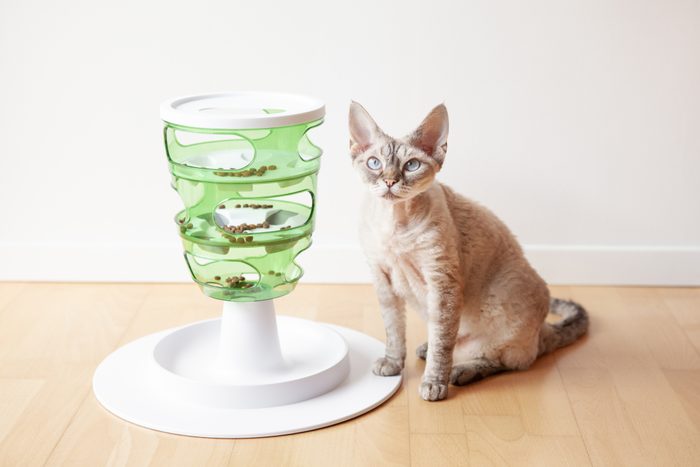
Make eating a more exciting experience
Cats are natural hunters and benefit from mentally stimulating activities. Playing with the laser or tossing around these top-rated cat toys are two ways to get their brains going. But consider adding some stimulation to their cat diet. “Administering treats through lick mats or food puzzles can be a great way to give your cat an enriching, mentally stimulating activity,” Dr. Miller says.
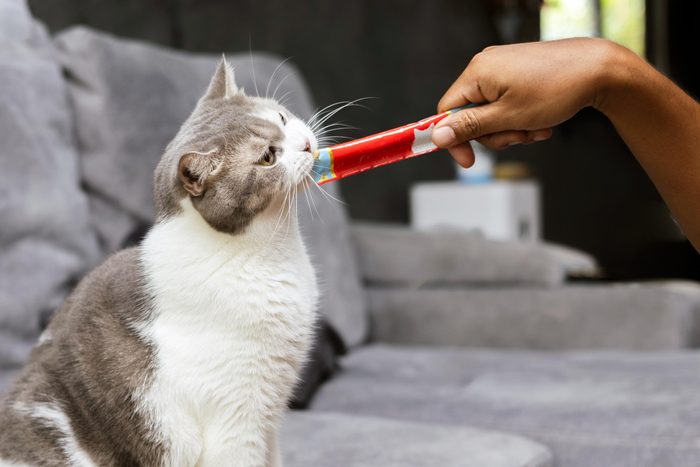
Don’t go overboard with treats
While cat treats are great for cat training, hiding pills or just celebrating a good kitty, they are generally higher in calories and therefore ought to be given sparingly. “Treats should make up no more than 10% of a pet’s diet,” notes Dr. Miller. Also think about how you’re giving your cat treats and consider using them in a strategic way to help train or curb certain behaviors, suggests the VCA.
If your cat ends up eating treats too often, it can disrupt their nutritional balance, impede their appetite for the food they really need, and can even cause them to become picky eaters.
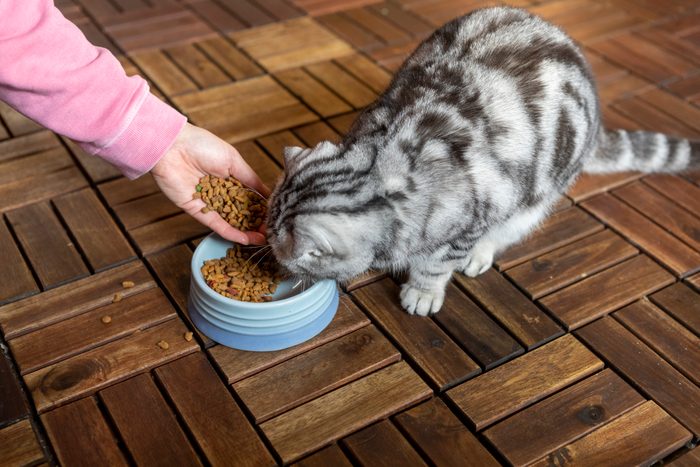
Take it slow when transitioning diets
Have you decided it’s time to make some changes to your cat’s diet? Whether you’re transitioning them to a new food to establish new habits or try something healthier, it’s very important to do this slowly. Dr. Miller recommends taking about 10 days to make the full switch. You can do so by starting with 90% of their old food and 10% of their new food, then slowly switching to 100% of the new food over a 10-day period.
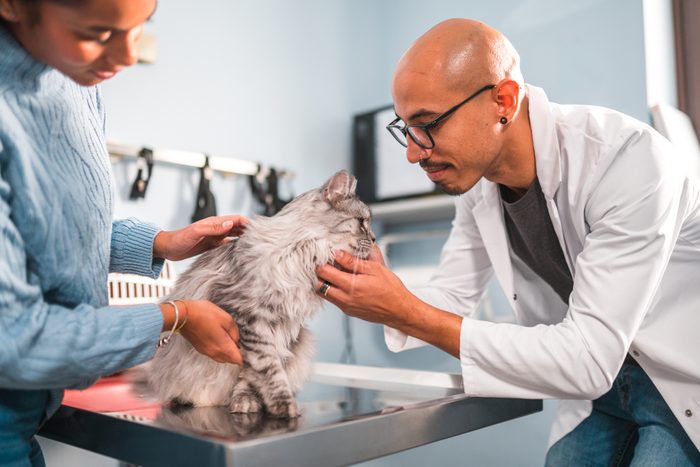
Consult your vet
Like humans, the best cat diet isn’t a one-size-fits-all situation. Some cats require a different approach to ensure they’re eating enough calories (or not too many), while others may benefit from high-water diets because of medications they’re taking. Dr. Miller says, “It’s important to remember that cats’ nutritional needs will likely change throughout the different stages of life, which is why you should periodically reassess their diet with your veterinarian.”
About the experts
- Whitney Miller, DVM, serves as Petco’s chief veterinarian, where she is the lead veterinary subject-matter expert. She oversees the company’s standards of excellence in animal care and welfare. She also leads the Petco medical team, which supports full-service hospitals and mobile vaccination clinics in more than 1,000 Petco pet-care centers nationwide.
- Jennifer Coates, DVM, is a veterinarian at Chewy. She is an accomplished writer, editor and consultant with years of experience in the fields of veterinary medicine, science, animal welfare, conservation and communications.
Sources:
- VCA: “Feeding Your Cat Well – An Overview”
- Association of American Feed Control Officials (AAFCO): “Selecting the Right Pet Food”
- American Animal Hospital Association (AAHA): “Mature Adult and Senior Cats”


















